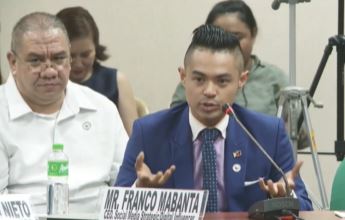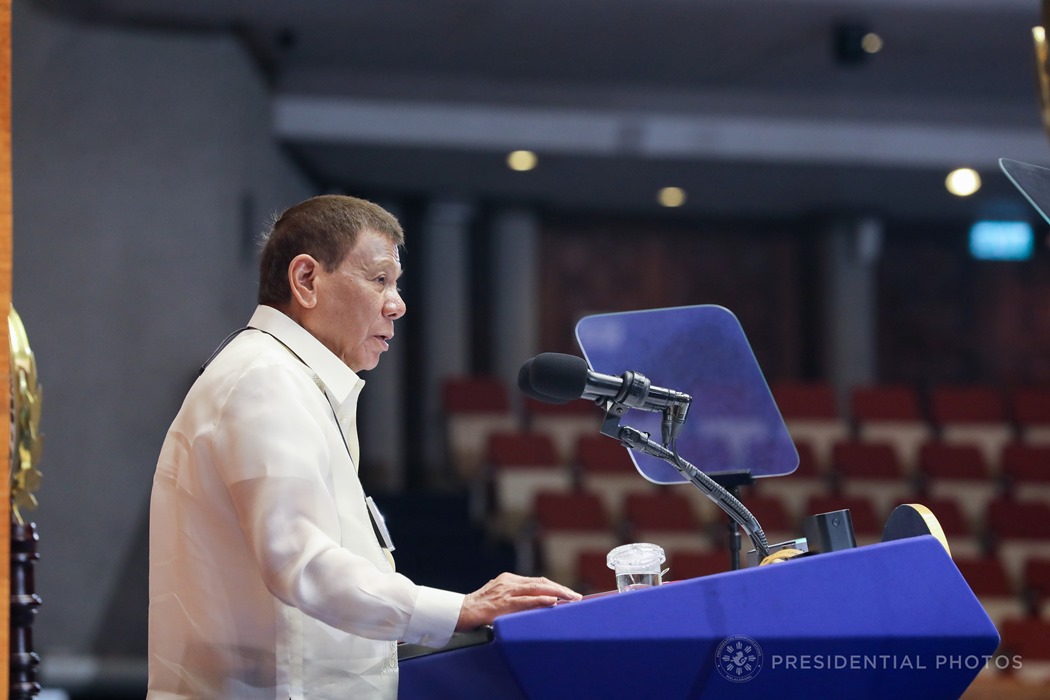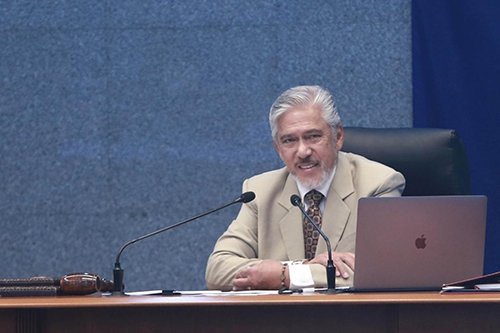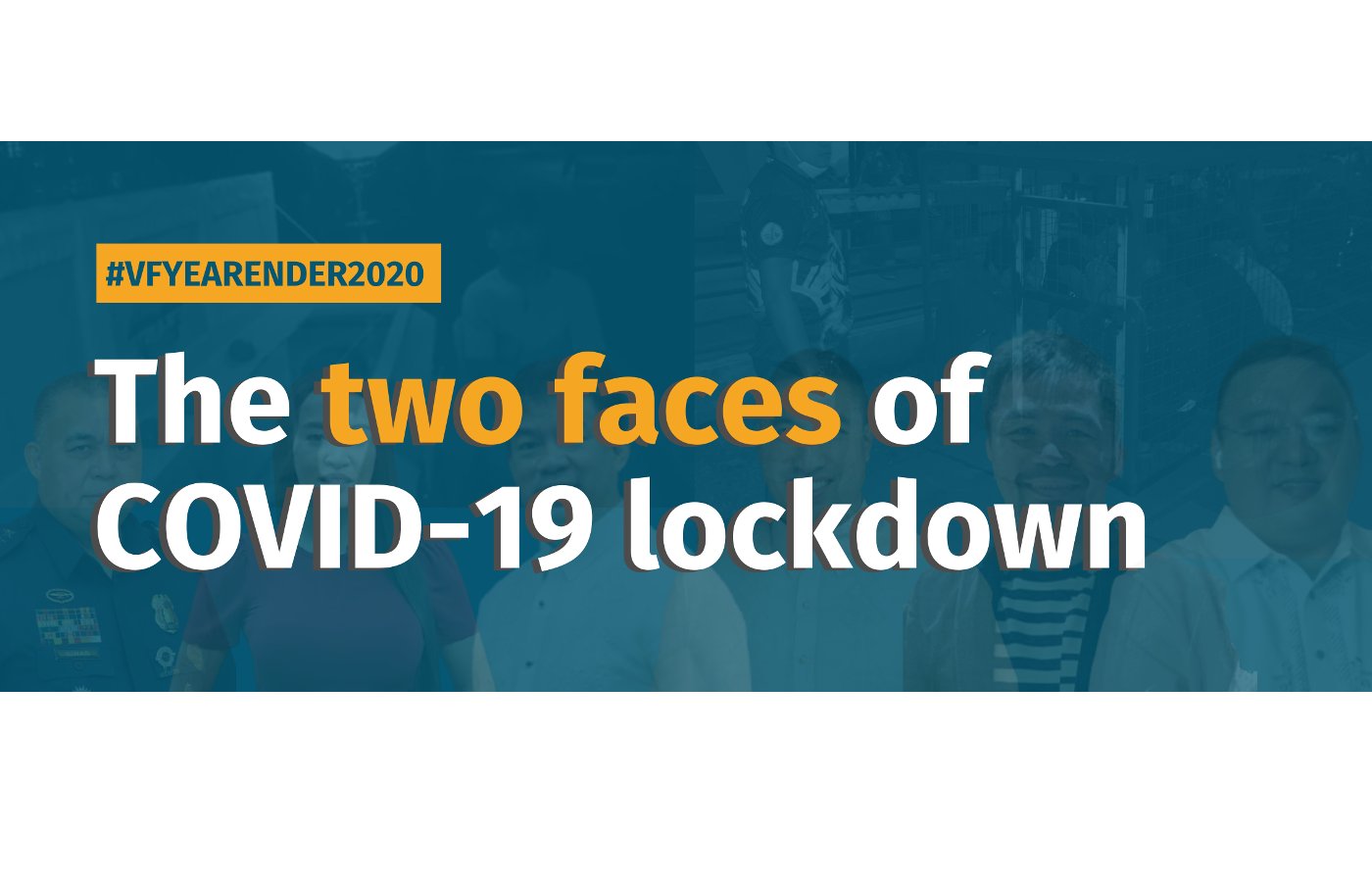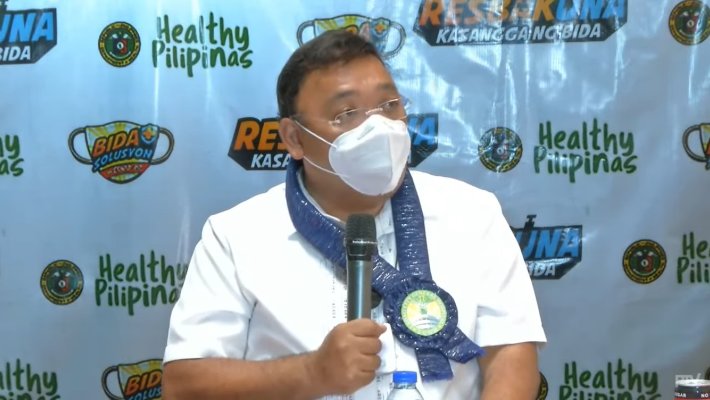(UPDATED) Self-proclaimed political operator and strategist Franco Mabanta, a supporter of President Rodrigo Duterte and defeated vice presidential candidate Ferdinand “Bongbong” Marcos Jr., wrongly said that the coronavirus disease 2019 (COVID-19) is the first pandemic “in a century.”
His other claim that the 17,727 reported COVID-19 recoveries in the country on Nov. 1 was “record-shattering” needs context.
STATEMENT
In a Facebook post on Nov. 2, Mabanta, former social media strategist of Marcos, said:
“22 hours ago, the Philippines was smashed by one of the strongest recorded typhoons in history, compounded by the economic and social stress of the first global (sic) pandemic (COVID-19) in a century.”
He added:
“Yet here we are facing a national record-shattering total of 17,727 new Covid recoveries reported on Sunday ALONE. (We usually take in about 400 to 600 recoveries a day.)”
Source: Franco Mabanta official Facebook account, Rise and shine!! It’s a beautiful, ultra-sunny Monday morning in Manila, Nov. 2, 2020 (Archived copy)
His post has so far been shared at least 222 times, with 110 comments and more than 3,500 likes and reactions, as of Nov. 16.
FACT
First, Mabanta is wrong in claiming that COVID-19 is the first pandemic in a century (100 years).
Since the 1918 ”Spanish flu,” at least five pandemics have occurred, infecting millions of people worldwide. These include the H2N2 virus (later known as the “Asian Flu”) in 1957-1958, the H3N2 virus in 1968, and the influenza A(H1N1) pandemic in 2009-2010.
The world also continues to deal with cholera, deemed the “longest running” pandemic since 1961, and the human immunodeficiency virus (HIV) since the first cases of acquired immunodeficiency syndrome (AIDS) were reported in 1981. (See VERA FILES FACT CHECK: Duterte errs on COVID-19 response timeline, pandemic history)
The most recent is the COVID-19, which the World Health Organization (WHO) declared as a pandemic in March.
WHO defines pandemic as “the worldwide spread of a new disease.”
Second, Mabanta’s claim that 17,727 new COVID-19 recoveries reported on Nov. 1 alone was “national record-shattering” lacks context.
The big number of recoveries reported on Nov. 1, a Sunday, was derived from the week-long data reconciliation process used by the Department of Health (DOH) under Oplan Recovery. The reconciled data under Oplan Recovery, released every Sunday since July, resulted in a bulk of new recoveries.
The highest number of recoveries ever reported by DOH was 40,397 on Aug. 16, which consisted of 39,843 time-based recoveries. But a review of DOH’s COVID-19 Tracker showed that those over 40,000 recoveries on Aug. 16 have been reduced to 4,184, as of Nov. 16, due to correction of data owing to delayed reporting or incomplete data submission.
According to data provided by DOH as of Nov. 10, at least 417 out of 34,315 cases were confirmed to have recovered on Aug. 16. The remaining 33,898 entries, with unspecified dates of recovery but announced on Aug. 16, were added to the date.
Meanwhile, another 703 entries composed of 236 validated as deaths, 120 reclassified as active (critical) cases, and 347 dropped as duplicate or deactivated have so far been removed from the recovery data for Aug. 16.
In a reply to VERA Files on Nov. 14, DOH explained that “…changes in outcome may be caused by the delay in updating of case status or incomplete data submission in our information systems.”
Health Undersecretary Maria Rosario Singh-Vergeire said Oplan Recovery is an initiative that involves “collection, validation and reconciliation” of data of COVID-19 patients between DOH and local government units. It was “activated to monitor the statuses of confirmed COVID-19 cases, particularly deaths and recoveries to ensure that our data is updated and accurate,” according to DOH.
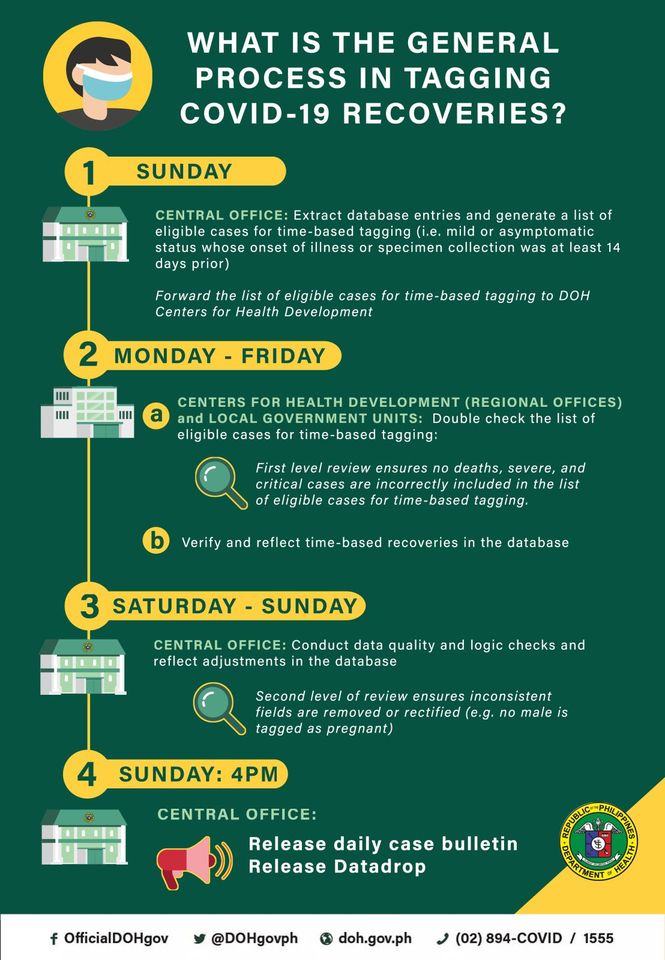
The weeklong process followed by DOH in reconciling data of COVID-19 time-based recoveries under Oplan Recovery. Photo courtesy: Department of Health
Under Oplan Recovery, the DOH uses time-based and symptom-based strategy as basis for releasing mild and asymptomatic patients who have completed 14 days of quarantine without showing any symptoms and having confirmatory testing to check if they still have viable coronaviruses in their body. Those patients are tagged as “time-based recoveries” in DOH’s COVIDKaya platform after the validation of data.
However, the time-based and symptom-based strategy does not apply to immuno-compromised COVID-19 patients, or those with underlying conditions such as HIV/AIDS, because they require a longer period of recovery and a different clinical assessment, including testing.
As of Nov. 16, 374,366 persons in the country have recovered from COVID-19, out of 409,574 infected. The number of deaths reached 7,839.
The Philippines’ recovery rate, or the proportion of the cumulative COVID-19 confirmed cases against those who recovered, is currently at 91.40%, while the case fatality rate is at 1.90% as of Nov. 16. The latest reproduction number of COVID-19 is 0.93, as of Oct. 30, meaning, a positive individual could infect an average of 0.96 persons.
The number of recoveries as well as the recovery rate, among other metrics, is important in tracking the progress of the government’s response against the COVID-19 pandemic. (See VERA FILES FACT SHEET: COVID-19 numbers used in measuring success of gov’t response explained)
UPDATE: Mabanta responded to this fact check in a Nov. 18 comment on VERA Files’ Facebook post. Read his reaction here.
Sources
Franco Mabanta official Facebook account, Rise and shine!!, Nov. 2, 2020 (Archived copy)
World Health Organization, Influenza – Past pandemics, Accessed Nov. 4, 2020
World Health Organization, World now at the start of 2009 influenza pandemic, June 11, 2009
World Health Organization, WHO Director-General’s opening remarks at the media briefing on COVID-19 – 11 March 2020, March 11, 2020
World Health Organization, Cholera: The Forgotten Pandemic, Oct. 22, 2018
U.S. Centers for Disease Control and Prevention, The Global HIV/AIDS Pandemic, 2006, Aug. 11, 2006
World Health Organization, What is a pandemic?, Feb. 24, 2010
Department of Health, Case Bulletin #232, Nov. 1, 2020
Department of Health, DOH REPORTS 39K RECOVERIES FROM OPLAN RECOVERY, Aug. 16, 2020
Department of Health, Alamin Aug. 1, 2020
Department of Health, Heads up!, July 30, 2020
Rappler.com, Department of Health updates on coronavirus in the Philippines | Sunday, August 16, Aug. 16, 2020
Department of Health, What is the general process in tagging… – Department of Health (Philippines), Aug. 22, 2020
Department of Health, TIME-BASED AND SYMPTOM-BASED STRATEGY, Aug. 12, 2020;
Department of Health , DOH TAGS 38K RECOVERIES FROM OPLAN RECOVERY, July 30, 2020
Department of Health, DOH ISSUES GUIDELINES ON EXPANDED COVID-19 TESTING, June 11, 2020
Department of Health, Case Bulletin #247, Nov. 16, 2020
LEADS for Health Security and Resilience Consortium, The LEADS for Health Security and Resilience Consortium, Accessed Nov. 5, 2020
Department of Health, DOH NCOV Tracker, Accessed Nov. 10, 2020
Department of Health, COVID-19 Philippine Situation No. 203, Nov. 16, 2020
Department of Health, LOOK: DOH COVID-19 CASE BULLETIN #155… – Department of Health (Philippines), Aug. 16, 2020
Mabanta as Marcos’s social media strategist
- Franco Mabanta official Facebook account, As many of you know…, Sept. 13, 2019
- PEP. Bongbong Marcos social media strategist Franco Mabanta gets bashed for encouraging ‘fat shaming’, April 14, 2018
- Rappler.com, Did Grace Poe tap Marcos ‘social media strategist’ Franco Mabanta as consultant?, Nov. 13, 2018
- Inquirer.net, Sanitizing martial law: When it’s more practical to forget, Jan. 1, 2019
Mabanta as political operator and strategist
- Franco Mabanta official Facebook account, I’m gonna really enjoy this.., Sept. 6, 2020
- Franco Mabanta official Facebook account, As of today.., April 8, 2019
(Guided by the code of principles of the International Fact-Checking Network at Poynter, VERA Files tracks the false claims, flip-flops, misleading statements of public officials and figures, and debunks them with factual evidence. Find out more about this initiative and our methodology.)
